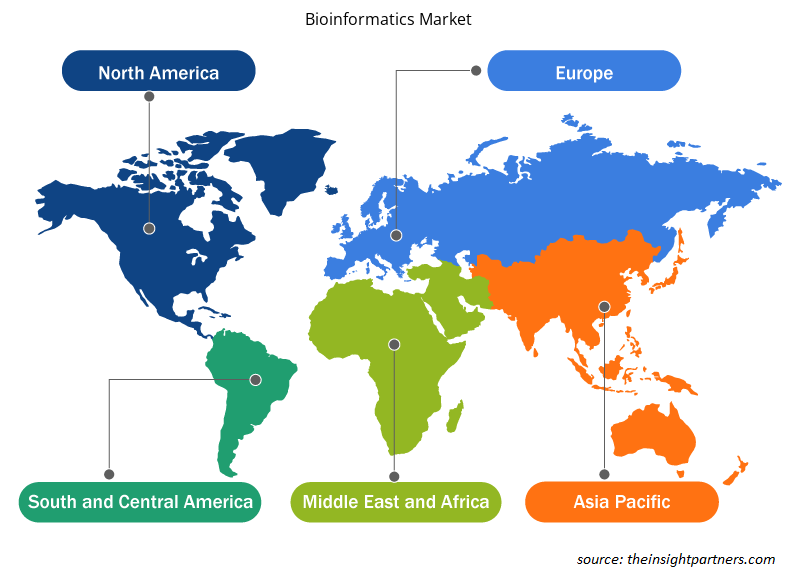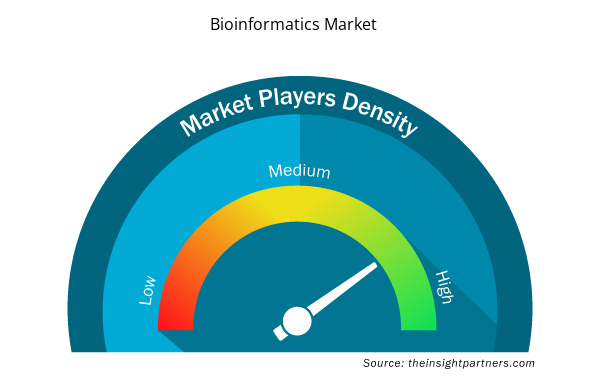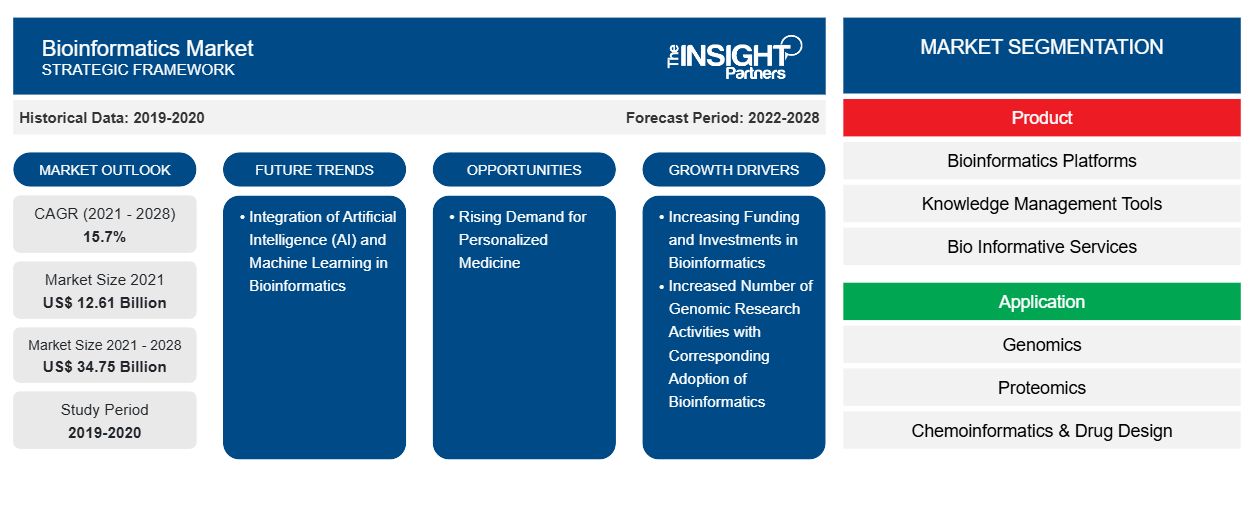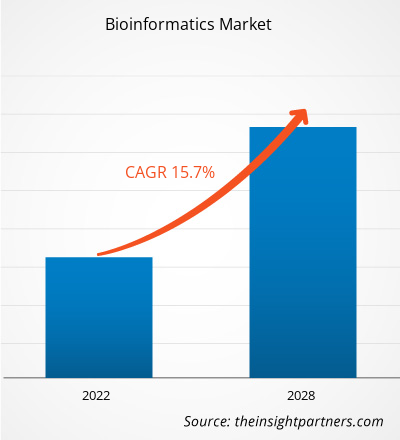[研究报告] 生物信息学市场预计将从 2021 年的 126.0939 亿美元增长到 2028 年的 347.4978 亿美元;预计 2022 年至 2028 年的复合年增长率为 15.7%。
市场洞察和分析师观点:
生物信息学是信息技术在管理生物数据方面的应用,有助于解码植物基因组。生物信息学存储、分析和解释生命科学实验产生的或在临床环境中收集的大数据。这个多学科领域由来自不同背景的专家推动,包括生物学家、计算机科学家、数学家、统计学家和物理学家。生物信息学允许研究人员在人的一生中重要的时间线上进行实验。例如,在冠状病毒大流行期间,研究人员能够在几个月内对病毒的基因组进行测序,确定可能导致病毒进入细胞的原因,并根据发现的基因组开发疫苗。其他生物信息学方法正被用于识别和治疗其他疾病,如糖尿病和癌症。生物信息学市场的增长归因于对生物信息学的资金和投资的增加,预计在预测期内,基因组研究活动数量的增加以及生物信息学的相应采用将推动生物信息学市场的增长。
增长动力和挑战:
在遗传学和基因组学领域,生物信息学有助于基因组测序和注释。生物信息学在基因和蛋白质表达和调控分析中发挥着重要作用。生物信息学工具有助于比较遗传和基因组数据,更广泛地说,有助于理解分子生物学的进化方面。人类基因组学研究和相关生物技术的作用有可能实现多项公共卫生目标,例如通过为发展中国家提供有效、经济、有效的预防、诊断和治疗其人口主要疾病的手段来减少全球健康不平等。目前,癌症治疗也将从基因组信息中获益,以预测个体对药物的反应,并指导开出适当的药物或剂量。
生成和收集人类基因组数据的计划正在迅速发展,而且高度多样化,多个国家都有私人和公共计划。自 1990 年以来,全基因组测序的成本从 270 万美元降至 300 美元,为建立基因组数据存储库提供了新的机会。到 2020 年初,全球共有 187 个基因组计划,其中 50% 源自美国,19% 源自欧洲。已经使用从基因分型到全基因组测序等技术分析了 3800 万个基因组,预计到 2025 年这一数字将增长到 5200 万个。因此,基因组学活动数量的增加以及生物信息学的日益普及正在推动市场的发展。
其中一个挑战是生物信息学是不同领域的集合——结构生物学、基因组学、化学生物学等——而且它们的发展都非常迅速。新技术几乎每天都在出现,新的数据类型也很多,因此跟上大量新事物的步伐非常困难。
定制此报告以满足您的需求
您可以免费定制任何报告,包括本报告的部分内容、国家级分析、Excel 数据包,以及为初创企业和大学提供优惠和折扣
- 获取此报告的关键市场趋势。这个免费样品将包括数据分析,从市场趋势到估计和预测。
报告细分和范围:
“全球生物信息学市场”根据产品、应用、行业和地域进行细分。根据产品,生物信息学市场细分为生物信息学平台、知识管理工具和生物信息服务。根据应用,生物信息学市场细分为基因组学、蛋白质组学、化学信息学和药物设计、转录组学、代谢组学等。根据行业,生物信息学市场分为医学生物技术、动物生物技术、农业生物技术、学术、环境生物技术、法医生物技术等。根据地理区域,生物信息学市场细分为北美(美国、加拿大和墨西哥)、欧洲(德国、法国、意大利、英国、俄罗斯和欧洲其他地区)、亚太地区(澳大利亚、中国、日本、印度、韩国和亚太其他地区)、中东和非洲(南非、沙特阿拉伯、阿联酋和中东和非洲其他地区)以及南美洲和中美洲(巴西、阿根廷和南美洲和中美洲其他地区)
节段分析:
生物信息学市场根据产品细分为生物信息学平台、知识管理工具和生物信息服务。生物信息学平台部分在 202 年占据最大市场份额1;然而,知识管理工具预计在预测期内将实现最高的复合年增长率。该细分市场增长的主要驱动因素是更先进和自动化的产品开发数量不断增加,以及中低收入国家/地区的可用性不断提高。生物信息学平台的发展帮助生物信息学市场显着增长。例如,2022 年 8 月,Predicine 在欧洲推出了其 CE 标志的 PredicineCARE,用于血液和尿液的基因组分析。无细胞 DNA (cfDNA) 检测是一种靶向的下一代测序 (NGS) 检测,用于检测被诊断患有癌症的患者的单核苷酸变异、插入和缺失、DNA 重排和拷贝数变异。该检测已用于临床试验、患者检测和伴随诊断的开发。
根据应用,生物信息学市场细分为基因组学、蛋白质组学、化学信息学和药物设计、转录组学、代谢组学等。基因组学部分在 2021 年占据了最大的市场份额;然而,预计化学信息学和药物设计在预测期内将在市场上实现最高的复合年增长率。由于创新产品的开发和行业细分领域的研究不断增加,该细分市场的增长将在未来几年得到增强。遗传学目前是医学领域最具活力的科学之一,遗传数据在医学的所有领域都发挥着至关重要的作用。在几年内,技术进步就从研究转化为临床测试,直接面向消费者 (DTC) 的基因检测显着增加。消费者通常无需人工界面或咨询即可在线获得结果,然后寻求专业建议。
根据行业,生物信息学市场分为医学生物技术、动物生物技术、农业生物技术、学术、环境生物技术、法医生物技术等。医学生物技术部门在 2021 年占据了最大的市场份额,预计在预测期内将实现最高的复合年增长率。该行业增长的主要驱动因素是不断进步和对生物信息学工具的需求不断增长。
区域分析:
根据地理位置,生物信息学市场分为五个主要区域:北美、欧洲、亚太地区、南美和中美以及中东和非洲。北美生物信息学市场基于三个主要国家——美国、加拿大和墨西哥进行分析。预计在预测期内,美国将占据最大的生物信息学市场份额。美国政府发起了各种研究计划来促进基因组研究,其中包括由 NIH 领导的“全民研究计划”,该计划提供了 2860 万美元的资金,用于在美国各地建立三个基因组中心。该研究计划将通过美国不同机构的生物信息学服务加速精准医学的发现。美国的支持环境加速了制药和生物制药产品的开发和商业化。该国的市场参与者因其创新获得了各种专利。因此,制药和生物制药行业针对各种遗传疾病和癌症研究的生物信息学服务和产品发布的增长将推动生物信息学市场的增长。例如,2022 年 6 月,加州生物技术研究初创公司 LatchBio 推出了一个端到端生物信息学平台,用于处理大型生物技术数据,以加速科学发现。它允许生物学家组织数据和运行流程,生物信息学家上传新的工作流程,计算生物学家进行下游分析。
亚太地区是全球生物信息学市场增长最快的地区,预计在预测期内增长速度会更快。该地区的市场主要由中国和日本等国家占据。这些国家生物信息学市场增长的因素是基因组学和蛋白质组学领域的进步,产生了大量需要解释和管理的数据。
生物信息学市场趋势:
生物信息学和人工智能在改变和推动医疗保健行业发展方面发挥着关键作用。在生物信息学的背景下,人工智能可用于促进临床研究和分析,从而有助于设计新药和疫苗、诊断疾病,甚至预测流行病。可穿戴技术是人工智能与生物信息学结合使用的一个例子。消费者已经熟悉多种类型的可穿戴技术,例如健身追踪器和手表,并将收集的数据用于个人用途。可穿戴技术在一段时间内提供实时数据,可以帮助跟踪趋势并识别潜在致命健康问题(如心脏病)的迹象,比实验室进行的抽检更快、更准确。此外,基因组测序在医学诊断中起着关键作用。机器学习赋能的 DNA 测序技术(如下一代测序)使研究人员能够在一天内对人类基因组进行测序,而传统的桑格测序技术则需要十多年才能对人类基因组进行测序。人工智能和机器学习在生物信息学中的融合展现了生物信息学市场的当前趋势。
Covid-19的影响:
由于疫情期间对 COVID-19 检测试剂盒的需求增加,生物信息学市场受到了积极影响。在生物学层面,SARS-CoV-2 和 COVID-19 研究涉及高通量技术,例如用于检测 SARS-CoV-2 基因组的下一代测序、存储 SARS-CoV-2 基因组和变体的数据库、用于分析和存储宿主-病毒相互作用的生物信息学软件工具和数据库。在医学层面,寻找治疗策略、识别 COVID-19 生物标志物、发现药物治疗靶点以及药物再利用的生物信息学方法(即使用已有的 COVID-19 疾病药物)是主要研究主题,这进一步推动了市场增长。此外,用于研究 SAR-CoV-2 毒力和促进疫苗开发的基于合成基因的技术的使用有所增加。
近二十年来,核酸扩增技术、自动 DNA 测序和生物信息学工具的发明和进步彻底改变了所有传染病病原体的表征和分类。生物信息学方法和技术越来越多地被纳入全球应对 COVID-19 疫情的许多领域,这是生物信息学在现代科学和医学中发挥重要作用的另一个重要而明显的证据。
生物信息学市场区域洞察
Insight Partners 的分析师已详细解释了预测期内影响生物信息学市场的区域趋势和因素。本节还讨论了北美、欧洲、亚太地区、中东和非洲以及南美和中美洲的生物信息学市场细分和地理位置。

- 获取生物信息学市场的区域特定数据
生物信息学市场报告范围
| 报告属性 | 细节 |
|---|---|
| 2021 年市场规模 | 126.1亿美元 |
| 2028 年市场规模 | 347.5亿美元 |
| 全球复合年增长率(2021 - 2028) | 15.7% |
| 史料 | 2019-2020 |
| 预测期 | 2022-2028 |
| 涵盖的领域 | 按产品
|
| 覆盖地区和国家 | 北美
|
| 市场领导者和主要公司简介 |
|
生物信息学市场参与者密度:了解其对业务动态的影响
生物信息学市场正在快速增长,这得益于终端用户需求的不断增长,而这些需求又源于消费者偏好的不断变化、技术进步以及对产品优势的认识不断提高等因素。随着需求的增加,企业正在扩大其产品范围,进行创新以满足消费者的需求,并利用新兴趋势,从而进一步推动市场增长。
市场参与者密度是指在特定市场或行业内运营的企业或公司的分布情况。它表明在给定市场空间中,相对于其规模或总市场价值,有多少竞争对手(市场参与者)存在。
在生物信息学市场运营的主要公司有:
- 达索系统
- 布鲁克公司
- 安捷伦科技公司
- 欧陆科技
- Illumina 公司
免责声明:上面列出的公司没有按照任何特定顺序排列。

- 获取生物信息学市场顶级关键参与者概述
竞争格局和重点公司:
全球生物信息学市场的一些知名参与者包括安捷伦科技公司、Biomax Informatics Ag、布鲁克公司、达索系统、Eurofins Scientific、Geneva Bioinformatics、Illumina、PerkinElmer、Qiagen、赛默飞世尔科技公司等。这些公司专注于新技术、现有产品的改进和地域扩张,以满足全球日益增长的消费者需求,并增加其专业产品组合的产品范围。例如,2020 年 3 月,日本领先的基因检测和研究公司 Genesis Healthcare Co. 在日本推出了 GenesisGaia 的新型基因组数据市场工具,用于研发,以提高行业研究人员在关键应用(例如加速药物发现、临床开发和精准医疗)中的生产力,以及加强个性化消费产品和服务的开发。
2021 年 1 月,Illumina, Inc. 推出 Illumina Connected Analytics (ICA),将基因组数据瓶颈转化为催化剂。这款全新集成的生物信息学解决方案提供了一个全面、私密、基于云的数据平台,使客户能够在安全、可扩展且灵活的环境中管理、分析和探索大量多组学数据。
- 历史分析(2 年)、基准年、预测(7 年)及复合年增长率
- PEST 和 SWOT 分析
- 市场规模价值/数量 - 全球、区域、国家
- 行业和竞争格局
- Excel 数据集



Report Coverage
Revenue forecast, Company Analysis, Industry landscape, Growth factors, and Trends

Segment Covered
This text is related
to segments covered.

Regional Scope
North America, Europe, Asia Pacific, Middle East & Africa, South & Central America

Country Scope
This text is related
to country scope.
常见问题
The medical biotechnology segment dominated the global bioinformatics market and held the largest market share of 29.18% in 2021.
Thermo Fisher Scientific and Agilent Technologies, Inc. are the top two companies that hold huge market shares in the bioinformatics market.
Global bioinformatics market is segmented by region into North America, Europe, Asia Pacific, Middle East & Africa, and South & Central America. The North America region is the held the largest market for the bioinformatics market during the forecast period. The large share of North America is attributed to factors such as the presence of decreased cost of sequencing, leading bioinformatics providers, government support for genomic research, increased awareness of bioinformatics services, and increased number of genomic research activities in the region are driving the growth of the bioinformatics market in North America. Also, it has a favorable funding scenario for research activities.
The CAGR value of the bioinformatics market during the forecasted period of 2022-2028 is 15.7%.
The bioinformatics platforms segment held the largest market share of 48.47% in 2021 in the global bioinformatics market.
Key factors that are driving the growth of this market increasing funding and investments in bioinformatics and increased number of genomic research activities with the corresponding adoption of bioinformatics are expected to boost the market growth for bioinformatics over the years.
The genomics segment dominated the global bioinformatics market and accounted for the largest market share of 28.33% in 2021.
Bioinformatics, as associated with genetics and genomics, is a scientific subdiscipline that involves using computer technology to collect, store, analyze and disseminate biological data and information, such as DNA and amino acid sequences or observations about those sequences. Bioinformatics is essential for the management of data in modern biology and medicine. Scientists and clinicians use databases that organize and guide biological information to increase the understanding of health and disease and, in certain cases, as part of medical care.
The Bioinformatics market majorly consists of the players such as Agilent Technologies, Inc, Biomax Informatics Ag, Bruker Corporation, Dassault Systems, Eurofins Scientific, Geneva Bioinformatics, Illumina, Perkinelmer, Qiagen, Thermofisher Scientific, Inc. among others.
The bioinformatics research during the COVID-19 pandemic has given an impulse to the development and adaption of various informatics techniques, including computational methods for tracing and tracking infected people, artificial intelligence methods and robotics applications to support remote patients assistance, collaborative data infrastructures for COVID-19 research and sentiment analysis methods for monitoring the impact of lockdown measures. The introduction of genomics and bioinformatics have contributed immensely to understand infectious disease from disease pathogenesis, mechanisms and the spread of antimicrobial resistance to host immune responses.
Trends and growth analysis reports related to Technology, Media and Telecommunications : READ MORE..
The List of Companies - Bioinformatics Market
- Dassault Systèmes
- Bruker Corporation
- Agilent Technologies, Inc.
- Eurofins Scientific
- Illumina, Inc.
- PerkinElmer Inc.
- QIAGEN
- Thermo Fisher Scientific Inc.
- Biomax Informatics AG
- Genebio
The Insight Partners performs research in 4 major stages: Data Collection & Secondary Research, Primary Research, Data Analysis and Data Triangulation & Final Review.
- Data Collection and Secondary Research:
As a market research and consulting firm operating from a decade, we have published and advised several client across the globe. First step for any study will start with an assessment of currently available data and insights from existing reports. Further, historical and current market information is collected from Investor Presentations, Annual Reports, SEC Filings, etc., and other information related to company’s performance and market positioning are gathered from Paid Databases (Factiva, Hoovers, and Reuters) and various other publications available in public domain.
Several associations trade associates, technical forums, institutes, societies and organization are accessed to gain technical as well as market related insights through their publications such as research papers, blogs and press releases related to the studies are referred to get cues about the market. Further, white papers, journals, magazines, and other news articles published in last 3 years are scrutinized and analyzed to understand the current market trends.
- Primary Research:
The primarily interview analysis comprise of data obtained from industry participants interview and answers to survey questions gathered by in-house primary team.
For primary research, interviews are conducted with industry experts/CEOs/Marketing Managers/VPs/Subject Matter Experts from both demand and supply side to get a 360-degree view of the market. The primary team conducts several interviews based on the complexity of the markets to understand the various market trends and dynamics which makes research more credible and precise.
A typical research interview fulfils the following functions:
- Provides first-hand information on the market size, market trends, growth trends, competitive landscape, and outlook
- Validates and strengthens in-house secondary research findings
- Develops the analysis team’s expertise and market understanding
Primary research involves email interactions and telephone interviews for each market, category, segment, and sub-segment across geographies. The participants who typically take part in such a process include, but are not limited to:
- Industry participants: VPs, business development managers, market intelligence managers and national sales managers
- Outside experts: Valuation experts, research analysts and key opinion leaders specializing in the electronics and semiconductor industry.
Below is the breakup of our primary respondents by company, designation, and region:

Once we receive the confirmation from primary research sources or primary respondents, we finalize the base year market estimation and forecast the data as per the macroeconomic and microeconomic factors assessed during data collection.
- Data Analysis:
Once data is validated through both secondary as well as primary respondents, we finalize the market estimations by hypothesis formulation and factor analysis at regional and country level.
- Macro-Economic Factor Analysis:
We analyse macroeconomic indicators such the gross domestic product (GDP), increase in the demand for goods and services across industries, technological advancement, regional economic growth, governmental policies, the influence of COVID-19, PEST analysis, and other aspects. This analysis aids in setting benchmarks for various nations/regions and approximating market splits. Additionally, the general trend of the aforementioned components aid in determining the market's development possibilities.
- Country Level Data:
Various factors that are especially aligned to the country are taken into account to determine the market size for a certain area and country, including the presence of vendors, such as headquarters and offices, the country's GDP, demand patterns, and industry growth. To comprehend the market dynamics for the nation, a number of growth variables, inhibitors, application areas, and current market trends are researched. The aforementioned elements aid in determining the country's overall market's growth potential.
- Company Profile:
The “Table of Contents” is formulated by listing and analyzing more than 25 - 30 companies operating in the market ecosystem across geographies. However, we profile only 10 companies as a standard practice in our syndicate reports. These 10 companies comprise leading, emerging, and regional players. Nonetheless, our analysis is not restricted to the 10 listed companies, we also analyze other companies present in the market to develop a holistic view and understand the prevailing trends. The “Company Profiles” section in the report covers key facts, business description, products & services, financial information, SWOT analysis, and key developments. The financial information presented is extracted from the annual reports and official documents of the publicly listed companies. Upon collecting the information for the sections of respective companies, we verify them via various primary sources and then compile the data in respective company profiles. The company level information helps us in deriving the base number as well as in forecasting the market size.
- Developing Base Number:
Aggregation of sales statistics (2020-2022) and macro-economic factor, and other secondary and primary research insights are utilized to arrive at base number and related market shares for 2022. The data gaps are identified in this step and relevant market data is analyzed, collected from paid primary interviews or databases. On finalizing the base year market size, forecasts are developed on the basis of macro-economic, industry and market growth factors and company level analysis.
- Data Triangulation and Final Review:
The market findings and base year market size calculations are validated from supply as well as demand side. Demand side validations are based on macro-economic factor analysis and benchmarks for respective regions and countries. In case of supply side validations, revenues of major companies are estimated (in case not available) based on industry benchmark, approximate number of employees, product portfolio, and primary interviews revenues are gathered. Further revenue from target product/service segment is assessed to avoid overshooting of market statistics. In case of heavy deviations between supply and demand side values, all thes steps are repeated to achieve synchronization.
We follow an iterative model, wherein we share our research findings with Subject Matter Experts (SME’s) and Key Opinion Leaders (KOLs) until consensus view of the market is not formulated – this model negates any drastic deviation in the opinions of experts. Only validated and universally acceptable research findings are quoted in our reports.
We have important check points that we use to validate our research findings – which we call – data triangulation, where we validate the information, we generate from secondary sources with primary interviews and then we re-validate with our internal data bases and Subject matter experts. This comprehensive model enables us to deliver high quality, reliable data in shortest possible time.


 获取此报告的免费样本
获取此报告的免费样本